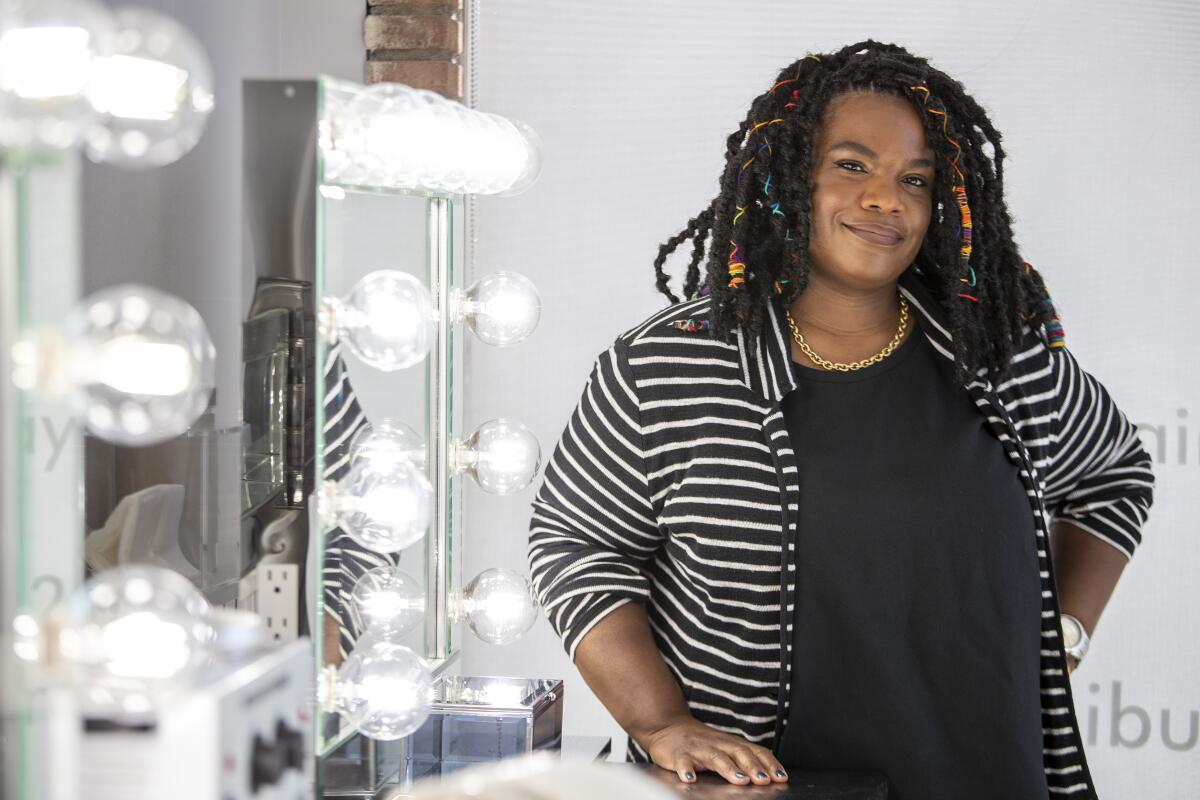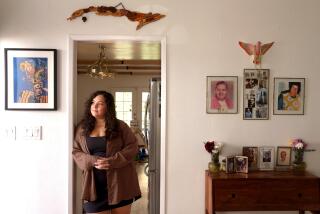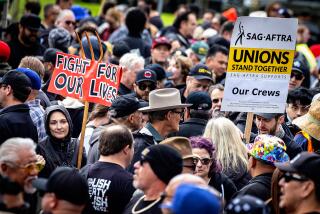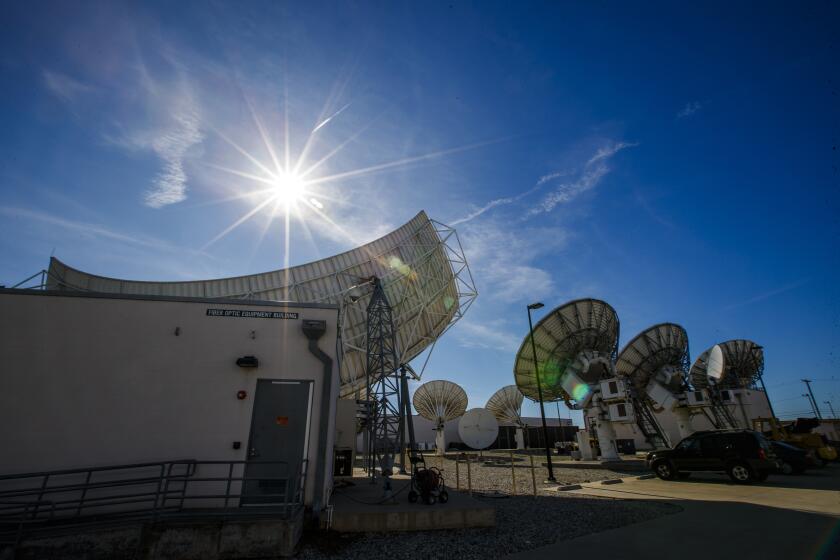Hollywood’s entertainment industry unions have a whiteness problem

It took April Chaney nine years working as a makeup artist before her union would accept her.
She needed to pay the $6,000 fee to get entry into the circle of workers considered for coveted jobs in entertainment. Even after joining the union in 2015 she said she applied for over 100 jobs without a call back.
A licensed aesthetician with her own Burbank-based salon, Chaney moved to Los Angeles from Alabama 17 years ago and didn’t have Hollywood contacts that can fast-track cast and crew into the ranks of its powerful unions.
“It’s very difficult, especially if you don’t know anyone,” said the 40-year old artist, who has worked on Hulu’s science-fiction series “The Orville.” “It’s even harder for people of color to get into our local. ... It’s about who you know and what relationships you have.”
After the protests over George Floyd’s death, studios and unions have been rushing to show solidarity with the Black Lives Matter movement by creating new diversity and inclusion measures and raising funds as workers across the industry speak out about systemic racism.
While campaigns like #OscarsSoWhite have cast a critical light on how Hollywood has overlooked the work of actors or directors of color, activists say significant disparities remain “below the line,” among the crew who staff film, television and theater productions.
These behind-scenes workers include makeup artists, grips, set decorators, film editors and other technicians are represented by various unions that remain overwhelmingly white and are often difficult to join for people of color.
Many underrepresented crew members face a catch-22.
“You can’t work on set unless you’re in the union, but guess what? You also can’t get into the union unless you’ve worked on a set for a certain number of hours and days,” said Brian Williams, vice president and chief operating officer of the L.A. Urban League, which runs apprenticeships in the entertainment industry for Black and other underrepresented communities. “So that chicken-and-egg game favors people who have connections.”
Tensions have erupted on sets. In June, high-profile Black and Latino stars criticized unions including the International Alliance of Theatrical Stage Employees (IATSE), which represents below-the-line workers, to address a lack of representation, nepotism and disparities in pay and hiring. IATSE vowed to “reshape” its union.
“We acknowledge that we have not always lived up to our own values and ideals of unionism, through our action, inaction, apathy, and at times ambivalence,” International President Matthew Loeb and General Secretary Treasurer James Woods said in a joint statement.
Amid the reexamination, several entertainment unions have formed diversity committees. A newly formed diversity committee for Teamsters Local 399 will soon hold its initial meeting, said Steve Dayan, secretary-treasurer of the union representing location managers, drivers and casting directors.
He declined to comment on the racial makeup of Local 399 but acknowledged that women and people of color are underrepresented in the union. Black members have raised concerns about not getting enough opportunities and of experiencing racism and microaggressions in the workplace, he said.
“It’s important for the unions to have these discussions so that we can bring issues to the studios,” Dayan said.
To get into Local 399, anyone working 30 non-consecutive days on a set in a year can join. But Dayan and other union representatives noted that producers and studios do the hiring.
The studios will pick a head of department, usually someone they have worked with before, who will then pick their teams. Dayan said he has pushed studios to hire more women and people of color into captain and transportation coordinator roles.
“We provide lists of names to the studios, but ultimately they decide who they’re going to hire,” he said.
Julie Socash, president of the Make-up Artists & Hair Stylists Guild, Local 706, also stressed that producers make hiring decisions.
She said her local is one of the few that allows work on non-union jobs to qualify for membership. That is how Chaney eventually managed to accrue enough time to join the union.
“All our members are treated equally,” Socash said. “We are not able to give preferential treatment to one member over another.”
Local 706, which does not collect any data on race or ethnicity of its membership, also recently formed a committee to tackle issues of diversity and inclusion, and is planning various educational initiatives around race and LGBTQ issues, she said.
Although data is scarce, people of color are substantially underrepresented on film crews, experts say.
“Anecdotally, it appears as if the numbers are really bad, but we haven’t been able to get our hands on reliable data to include in our studies of Hollywood diversity and inclusion,” said Darnell Hunt,
dean of social sciences at UCLA.
The Directors Guild of America has tracked diversity in its ranks for many years. The DGA posts the breakdown of its membership, which includes unit production managers and assistant directors as well as directors.As of July 2020, the guild reported that only 5% of its 18,000 members are African American and 4% are Latino.
In some technical film jobs there are almost no women of color. A study by USC’s Annenberg Inclusion Initiative found no women of color as directors of photography in the top 300 movies from 2016 to 2018. Men of color accounted for 15.8% of cinematographers. White men accounted for 80% of film editor positions, while 94.1% of production designers were white and 14% of costume designers were from diverse racial/ethnic groups.
“If the numbers are not changing, the ecosystem is not doing enough to ensure that everyone is getting access and opportunity,” said Inclusion Initiative founder Stacy Smith. “Traditionally, it has been that folks who are connected to others in the industry that get access. That closed system must change. “
For costume designers of color, the way in is most often to work under a union member, said Provi Fulp.
The 38-year old Atlanta resident, who is working on the DC Comics TV series “Black Lightning,” was a costume designer for seven years before joining her union in 2016. She needed letters of recommendation and paid thousands of dollars to become a member of the Costume Designers Guild, IATSE Local 892.
But it wasn’t until she met veteran designer Danielle Hollowell, who brought Fulp in as an assistant costume designer on the hit movie “Girls Trip,” that she got the guidance she needed, she said.
“You really have to find someone of your own culture , Brown or Black, that would be willing to take you under their wing and literally walk you through the process just to get in.”
Today, Fulp, who is African American and Puerto Rican, is part of a new diversity committee at the union, whose president, Salvador Perez, is Mexican American.
“I feel a lot more supported now with the diversity committee and to see non-melanin people want to actually make a change and say, ‘You know what, if I get a job that maybe I’m not familiar with the culture, that maybe I’ll suggest someone who may be more culturally appropriate,’” she said of the conversations the designers are having. “Because a lot of times we just don’t get the offer.”
Rachael Stanley, executive director of the Costume Designers Guild, said the union was gathering statistics of the makeup of its membership, but she believed that it was more diverse than “many of the locals.”
“We are not closed to any group,” Stanley added. The union, which has an outreach program for students, is about 82% female, she said. “You can see the diversity in our membership at any of our meetings.”
A post on Facebook looking for recommendations for Black film editors was met with protests by some white film editors claiming discrimination.
Like Fulp, Pasadena film editor Ri-Karlo Handy recalled being one of very few Black people in the room at his first union meeting.
This summer, Handy faced a social media backlash after he posted a notice on Facebook seeking to connect with other Black members of the Motion Picture Editors Guild, Local 700. Some white editors claimed “reverse racism.”
Since then he has built a list of 242 Black editors and assistant editors, but only 95 were union members, he said. He estimates only 2% of the over 8,000-members of the local are Black.
“Hollywood is made up of these silos, private groups, peer groups — whether it’s the academy, whether it’s the unions — where you may have individuals inside of those groups that want to be inclusive, but the system, the structure that’s set up to get you into those groups, has not changed for years,” Handy said.
Cathy Repola, national executive director of the Editors Guild, Local 700, declined to confirm Handy’s low estimates of Black membership, saying the union is surveying members to collect anonymous demographic data, she said.
Repola said there was “no prohibition against getting in the union,” but said the local was exploring ways to to improve diversity in post production. The leadership is “100% supportive of doing more and doing better,” she said.
Some crew have struggled to get entertainment industry unions to represent them. Some 800 parking production assistants working for broadcast networks who are mostly people of color, had to go outside the usual entertainment unions to become unionized, joining the Communications Workers of America in 2018.
At a virtual town hall earlier this summer held by the Location Managers Guild International, location managers of color shared their experiences of racism on set and being threatened while scouting. One location manager said while working in Philadelphia, a resident threatened to shoot him when he was notifying them of filming.
Board member Alison Taylor, who moderated the meeting, noted how her career was helped by Black creators such as Issa Rae and Ava DuVernay who pushed for more people of color in the ranks.
Working with the director of “Selma” “was probably the first time that I really saw someone come in and say, ‘Listen, mix it up, the crew needs to look like Los Angeles,’ and I wanted to jump up and applaud her every time she came in the room,” Taylor said in an interview.
Producers and the major studios could do their part by pushing for” disadvantaged persons to be allowed to get job experience on their set,” said the L.A. Urban League’s Williams. “They can also contribute to training and apprenticeship programs” as part of creating a pipeline of talent, he said.
Tyler Perry was among the first major filmmakers to restart shooting amid the coronavirus outbreak. He followed rigorous health and safety measures at his Atlanta studio.
Producer Tyler Perry, who recently completed production on his TV show “Sistas” in Atlanta with strict safety protocols to protect his largely Black cast and crew, said unions have been supportive of his work but the solution is for more Black creators to be able to tell stories.
“You can beg and you can ask and you can knock down doors and you’ll get some progress,” Perry said. “But if you want to see long-range change that lasts for a long time ... then you absolutely want to have more ownership. And that may not be the immediate answer because it took me 20 years to get here. But that is definitely the answer.”
More to Read
Inside the business of entertainment
The Wide Shot brings you news, analysis and insights on everything from streaming wars to production — and what it all means for the future.
You may occasionally receive promotional content from the Los Angeles Times.











